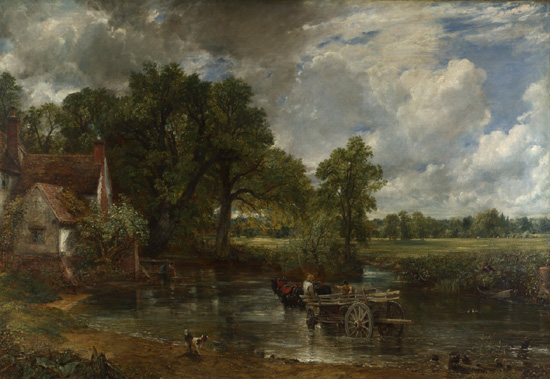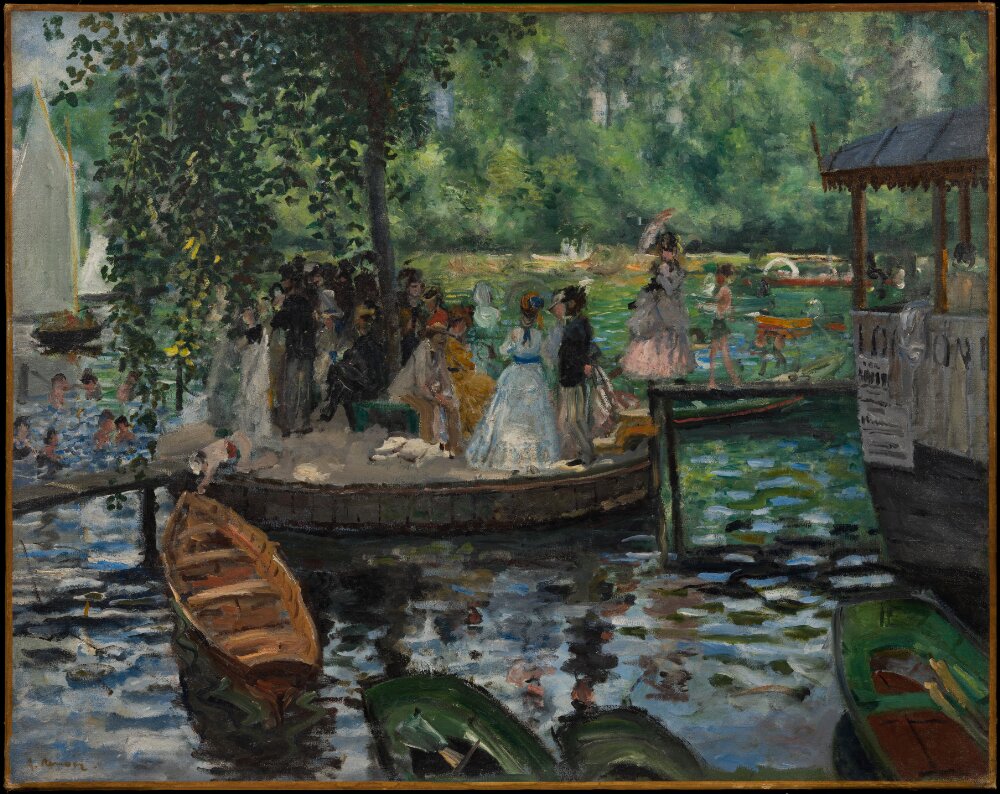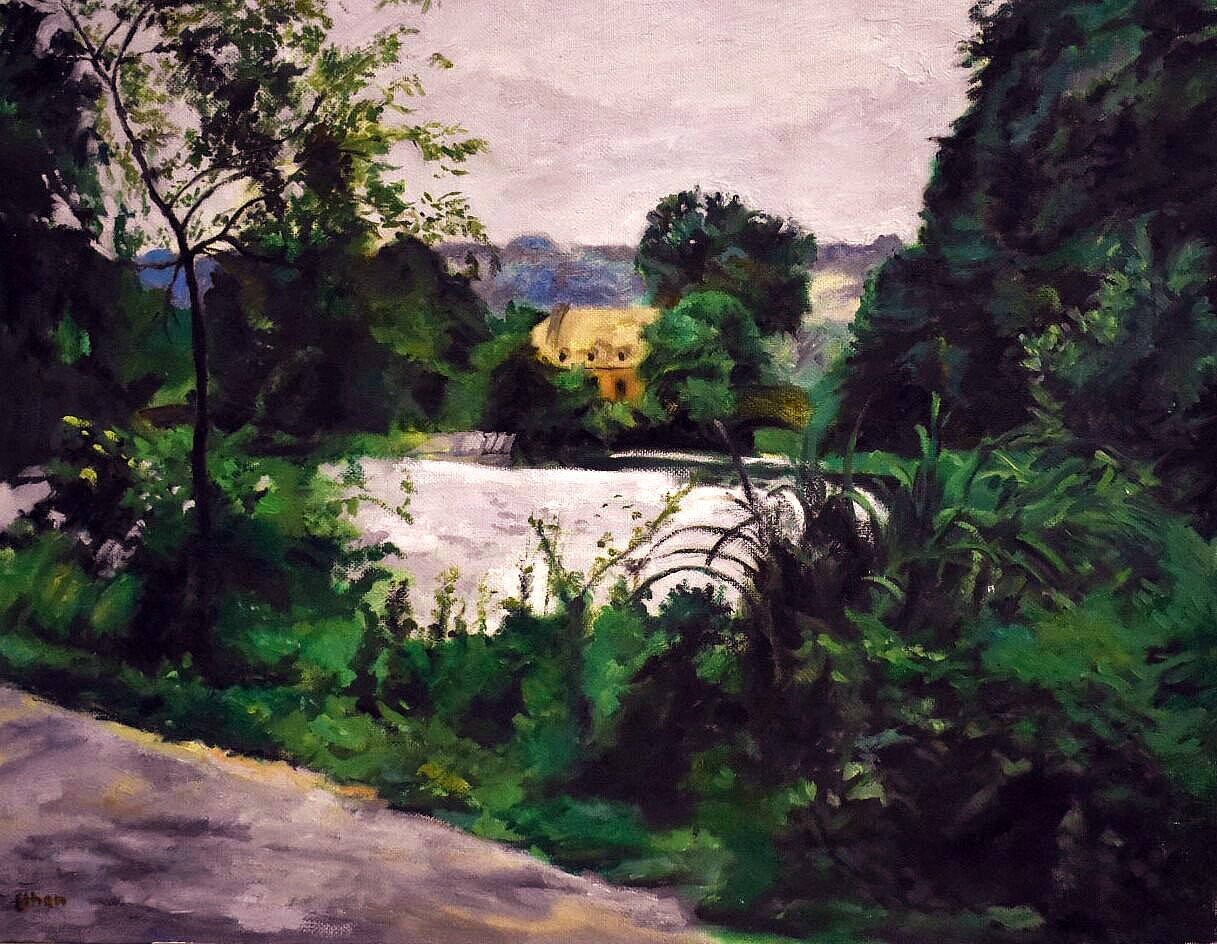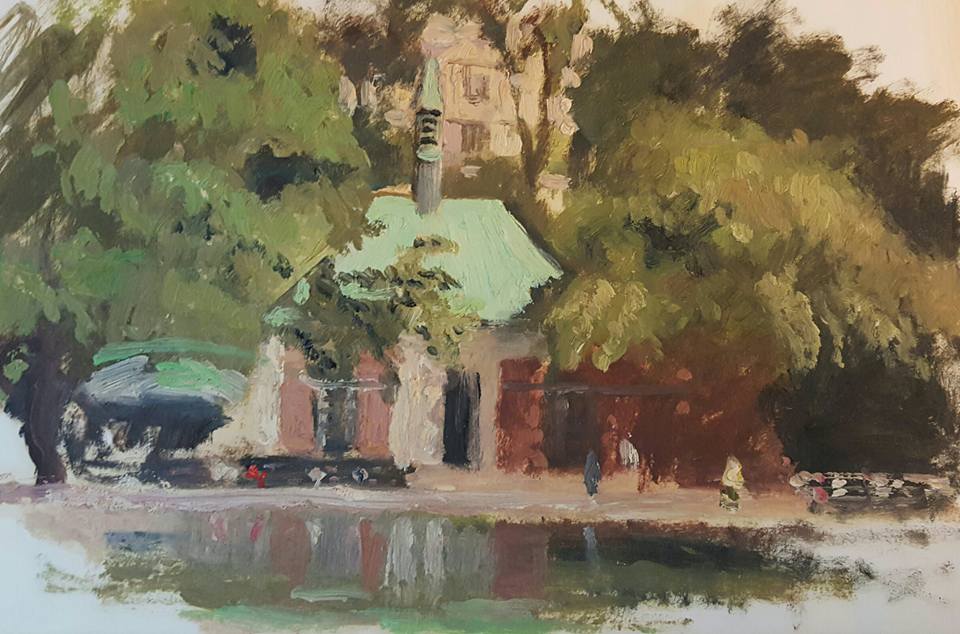Many people started to paint by following those “wet on wet” tv painters on PBS stations. I suppose Bob Ross is the most known of them although he wasn’t the originator of that way of painting. That would be William Alexander.
Anyway, the guy was fun to watch – I mean we all know that. I had fun watching him too. And, have you ever met a guy who seemed to be a nicer and gentler person? I mean, come on.
So when I say the “Bob Ross painting technique” what I’m referring to are those painters that use things like “magic brushes” or a “foliage brush”, “liquid white” etc. and teach you to paint trees by doing something such as
“loading a corner of the 2 inch brush and tapping from side to side” – that sort of instruction.
Now, I teach oil painting, but that is not the methods, or type of painting I teach.
If you have been to art museums and seen traditional works of art – that’s what I teach.
So this article is for people who currently paint the way I described above and would like to go beyond that way of painting. Those people who perhaps have doubts that they can.
For someone who is more traditional minded and serious about learning to oil paint, the above methods are not going to get you where you are hoping to go. It is not the way the greatest painters of the past have painted.
Let me explain a little more…please take a look at this…

 This is a landscape painting by John Constable. It is called The Hay Wain. Possibly his most famous painting. John Constable is recognized as one of the greatest landscape painters in history. He was an English painter in the early 1800’s
This is a landscape painting by John Constable. It is called The Hay Wain. Possibly his most famous painting. John Constable is recognized as one of the greatest landscape painters in history. He was an English painter in the early 1800’s
Here is another landscape, with water by Pierre Renoir…


Renoir was an impressionist. His technique was different than Constable’s, but not to the degree that you may think.
Can you see the difference between the Constable, the Renoir and those using what is referred to on tv as the “wet-on-wet” technique?
On a side note: “Wet into wet painting is nothing new. Painters have been using wet into wet paint since painting began. It’s a term that has been used for branding purposes to describe the method, and that’s fine. But Artists from Titian to Monet have painted wet on wet.
Anyway…I suggest you get yourself to any art museum near or in a large city and look at the landscape paintings by the great painters of history.
The difference is not simply darker colors, or that the traditional paintings look more real. The difference will be immense and most noticeable in person. You should be able to see it immediately.
And, when I talk about this concept, there are always a few people who defend this way of painting as being just as valid as the way Rembrandt, for example, painted.
But don’t take my word for it. I have a simple test that you can do for yourself
Here it is…
1) Go to a park or some outdoor area near where you live with your portable easel, paintbox, etc.
2) Pick a scene you consider beautiful or scenic.
3) set up your canvas and use the supplies you have and what you have learned to paint that scene you see in front of you.
If you have no problems, don’t feel any frustration or confusion – Great! I was wrong.
But, if you do – then ask yourself if you are satisfied or you have more to learn? And most importantly – if you want to learn more.
And, if you have doubts that you can learn to paint like the paintings in museums. That you really can do it. I know that you can and I’ll let you in on a little secret on a minute…
These next paintings are by me.



I’m showing you them ( and notice the different subject matter) because…I Started Out Painting following those painters on tv too. I had my 2 inch brush, my fan brushes, learned some tricks to paint a tree, painted some mountains and thought I was a painter now.
I convinced myself that old master way was too hard, too tedious, took too long…and every other reason and excuse I could think of. After all, this was just as good.
Let me explain one of the main misconceptions people have.
Beginning artists think you learn “how to paint a landscape” or “how to paint a tree” or “how to paint flowers”, or whatever subject matter you wish to paint.
But, the truth is – to paint in the traditional manner you don’t learn how to paint subject matter. You learn to paint – period! You learn the rules of your art supplies and the language and techniques of painting. You learn the process of oil painting. And then you apply this process to anything you want to paint.
Please, re-read that again.
If you would rather be painting in a way similar to Monet and Rembrandt, you can. It isn’t too difficult for you and I am proof of that.
Become master of your medium. Master of your tools. I’m going to assume that few tricks for one type of subject matter will not satisfy you.
If you have always wanted to become a painter in the traditional sense, you need to take that next step.
Now, is this for everyone? Of course not. If you are content painting this way, great. but my lessons will not be for you.
I am writing this article for people who currently paint using what is commonly called using the “wet on wet” method and want to go further.
Think of it like this, If you learn the alphabet, you can spell any word. Essentially what you are doing by painting in the manner you are is just learning how to write the letter “A”.
How can you expect to spell any word you want without learning the other 25 letters?
You have gained some experience by using painting supplies though. This is a start. Now it is time to take that next step and learn more.
Learn the way painters have been painting for hundreds of years. You may like watching those video demonstrations of a landscape in 27 minutes, well I recommend you check out my set of 7 Instructional DVD’s if you want video instruction that covers traditional methods and procedures.
Remember, I started out painting by following those tv painters too. But now, I can paint anything, and any way I want to. You too can go beyond your current painting you are doing and paint the way the greatest masters in history have painted.
I can show you how with my 7 DVD Oil Painting Instruction Series

WOW, you sure are gorgeous! Aside from that, I do have a question, the painting at the very top of this page reference, “Painting with Ross, going beyond that”, oh my God, I was about to ask a really, really stupid question, and that was, did you paint that? But, as I scroll back up to make sure it in fact is the top painting, I see that is a very famous landscape by John Constable, so please disregard, however, yours are quite nice as well, I have been looking at your lessons, for, I can’t even remember but how long but, it’s been several years. Thanks for the constant direction and inspiration!!!
I just found that Landscape to be quite beautiful, sorry, I can now no longer give you the credit!!
OK, so perhaps, I should stick to art and avoid any online communication at the risk of looking like a complete idiot!! LOL
Melinda in Florida
Who cares if you like Wet on wet, who cares if you like the “masters” ?
Somedays I paint “Bob Ross” style, other times I paint something for 5 weeks “classical” style.
Pretty much straight forward, I can let loose and have fun with the Bob Ross style and seriously that picture you used to compare is really really sad, some of my wet on wet stuff is just as good as some of my classics.
It is all about developing your style, like what your DVDS sound about.
But attempting to make the wet on wet technique look like a childs picture is really low, many many people get much better quality from their wet on wet.
The problem is every one is stuck in the freaking middle ages still, who decides what is better…. YOU? Some stupid art “expert”? Surely all you need to do is go look at art exhibitions and you’ll see how pathetic the traditional arts are.
BTW: Van Gogh….wet on wet? Am I correct? How many others painted alla prima? How is Monet or Rembrandt a better painter ? That is only your view, someone may love Jackson Pollock stuff, I don’t but it doesn’t mean that he was not an artist?
Please do not discredit someone on your own belief, many, many out there disagree with you.
Kind regards
More interesting than your actual comment is the fact that you felt the need to get defensive on Bob Ross’s behalf, which makes it sound much more like you thought you were personally being attacked because you paint in his style. Otherwise…why so defensive?
Wait, I know the answer. It’s because you didn’t actually bother to read the post. If you had, you’d realize what he’s actually saying, and know that your criticism is invalid because he didn’t do what you’re accusing him of.